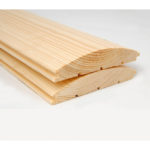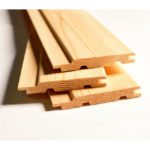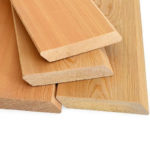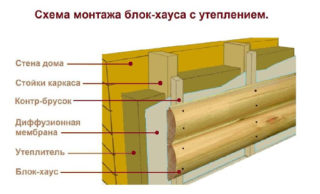Wood is one of the classic materials for construction and exterior cladding of dwellings. For cladding a building, a facade board is widely used. Due to the aesthetic qualities and ease of installation, this cladding method remains widespread to this day.
What is the facade board made of?
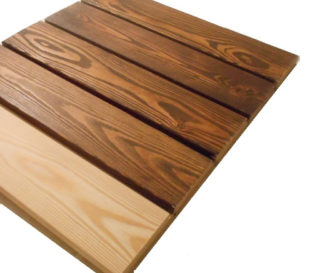
In the past, planking of the facade was usually carried out using building materials made from softwood. Nowadays, a wider range of raw materials is used for work, including composite materials containing polymers. Products differ in thickness, texture and method of fixing.
Larch
Facade boards are often made from larch for exterior decoration of the house. This breed attracts with its affordable price and minimal need for protective impregnation. The latter is due to the high content of resinous compounds, due to which the tree is less susceptible to rotting and fungal attack. But if the building is located in an area with humid air, the boards must be pre-treated with a moisture-proof compound.
Tropical tree species
Such boards for the facade are attractive for their noble and memorable appearance, textured pattern. These include teak, wenge, kempas. Like larch and cedar, these species are highly resinous. They can be used to decorate a building in which a restaurant, holiday home or similar establishment is equipped - then the room will be remembered for its appearance. However, they are more expensive than the breeds widely available in Russia.
Linden, birch, ash
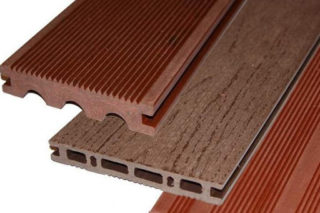
Such trees are not very suitable for decorating a building from the outside, as they are susceptible to mold damage and deterioration under the influence of moisture. They must be subjected to preliminary heat treatment. It increases the strength of the wood and improves its performance.
KDP
WPC for the facade is a building material containing natural and synthetic components. The wood base is treated with polymer compounds. This provides the facade composite board with resistance to fungus, ultraviolet rays, temperature fluctuations, insects. Also, stable dyes are used in the production.
A wide variety of colors of the facade decking allows you to choose an option that suits the purpose of the room and the taste of the owner.
Facade board profile
Cladding boards for external walls differ in profile and fastening method. The latter depends on the design features of the finishing products.
Lining, block house or imitation of a bar
These types of materials are similar in the installation method. They are equipped with tongue-and-groove connections and fit without gaps.
Planken
Such a product looks like a well-planed board, devoid of protrusions and grooves. When such products are mounted on a facade, a technological indent is provided between the elements so that the panels swelling from damp air do not provoke changes in the shape of the entire plane. At the same time, the board is easy to dismantle and install a new one without disassembling the entire structure. Panels can have beveled or rounded corners. In the first case, they can only be installed horizontally.
Wood siding
This material usually has a mixed composition.For its production, a wooden base and polymer additives are used.
Advantages and disadvantages
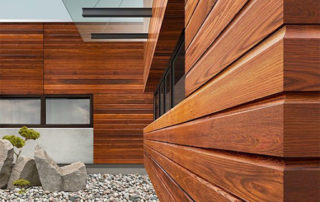
The availability of the material and its attractive appearance make it very popular. Wooden products are easy to assemble: work can be done without the qualifications of a builder. If the board has deteriorated, it can be replaced with a fresh one without disturbing the overall structure. Wood panels are produced in a wide variety of designs and colors, so you can always choose an option that suits the design of the house and climatic conditions.
Planken allows you to organize a ventilated facade system. In addition, it extends the service life of insulation materials by preventing the accumulation of condensed moisture.
Wood requires some processing, especially if the house is located in a humid climate. The boards need to remove irregularities and knotty, sanded, treated with substances that protect against decay and mold. Even an unedged board is suitable for finishing, provided that it is properly processed.
DIY installation instructions
Sequence of work:
- Select fasteners suitable for the wall material. If the house is built of timber, self-tapping screws or simple nails will do. Anchors or dowels are needed for a brick building.
- The bars from which the crate structure will be made are carefully treated with an antiseptic. Walls outside should be covered with a water-repellent compound.
- The structure is stuffed onto the facade. In this case, you need to try to smooth out uneven places on the plane. If the installation of thermal insulation is planned, it is placed under the crate.
- Finishing boards are reinforced on the frame. In some cases, the issuing company indicates exactly how to mount them. Sometimes fastening parts are supplied in the kit. The panels are placed perpendicular to the battens.
- When finishing the corner parts, it is possible to practice undercutting the ends or joining with a checkerboard.
If wood without polymer additives was used for cladding, at the end of the work it must be covered with a composition that has protective properties and improves its appearance. It can be varnish or stain.
Façade board care rules
If the house is lined with a board, and not with composite materials, the surfaces should be cleaned, if possible, using a dry method. If you need to remove grease, use special wood products in combination with a soft brush.
Composite materials can be cleaned with a cloth or water hose. In this case, the jet should not be directed under pressure. The use of karcher and similar units is prohibited.

